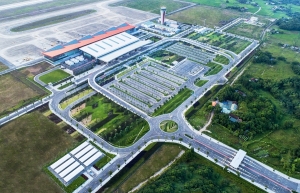Airport plans depend on investment
*--*--*
The Ministry of Planning and Investment (MPI) is currently making efforts to outline the master plan for the development of airports over this decade, with a vision for 2050, to align with the development of the country as well as meet the demand of investors and localities.
 |
| Roundtable: BUILDING SMALL AIRPORTS FOR LOCAL ECONOMY TAKE-OFF |
Trinh Duc Trong, vice director general of the MPI’s Department of Infrastructure and Urban Development said, “We are struggling to juggle proposals from investors while dealing with local governments on developing airports, as well as defining the direction of the country’s development. The master plan should be based on not only the demand of investors and localities, but also factors like resources allocation, efficiency, and the contribution to socioeconomic development.”
Trong noted that the current performance of local airports is questionable because very few operating airports are making a profit, while most of them are suffering losses. “The development of these local airports will be essential if the development of the economy, tourism, and people’s livelihoods are improved significantly,” said the MPI official.
Due to the increase in travel demand before and after the pandemic peak, some airports have been overloaded. In Tan Son Nhat International Airport, congestion can be found from the parking lots and check-in to security and boarding areas, with a lack of seats for passengers in every section. Even the planes themselves often have to wait in line to take off or circle the sky before landing because of a lack of space.
In some cases, airlines cannot manage flight timetables efficiently because of overload, poor management of aircraft parking, slow security screening, slow bus delays, lack of runway vehicles, and baggage carousel jams.
For these reasons, many airlines have requested to self-operate ground services at terminals to proactively plan their business and improve service quality for their passengers. However, not every proposal is accepted.
At present, terminal T2 at Danang International Airport and T2 at Cam Ranh Airport, which were built by private investors, report better efficiency and investment rates than others run by Airports Corporation of Vietnam. However, operation management is still handled by the corporation, so the quality of service has not much breakthrough.
The representative of one airline said that in order to improve the quality of airports and enhance capacity, the contribution of the private sector to development, operation, and management is essential.
“Private investors will contribute to dynamic services, diversifying revenue sources, and enhancing quality. The number of airline brands is few and the competition is bad, while the biggest bottleneck is infrastructure. If the monopoly continues, the infrastructure will get weaker and services will become stagnant,” he said.
On October 11, VIR will hold a roundtable on local airports and their economic prospects, which will feature the participation of dozens of policymakers, experts, and businesses in aviation. They will discuss the important role of local airports in tourism development, investment promotion, export and import, and ease of transport, as well as propose some solutions to encourage private investment in the sector.
“If forecasts and the master plan are carried out with high accuracy, private investment will be poured in a proper way to generate benefit for them, as well as significantly contribute to the socioeconomic development of the country,” said Trong from the Department of Infrastructure and Urban Development.
| ‘BUILDING SMALL AIRPORTS FOR LOCAL ECONOMY TAKE-OFF’ Roundtable organised at 8.30am – 11.30 am on October 11, 2022. Speakers 1- Phan Duc Hieu - Standing Member National Assembly Economic Committee 2- Nguyen Trong Hai - Vice Chairman Lao Cai People’s Committee 3- Nguyen Van Vinh - Deputy director Vietnam Institute for Development Strategies, MPI 4- Dr. Nguyen Dinh Cung - Former director Central Institute for Economic Management 5- Dr. Tran Dinh Thien - Former director Vietnam Institute of Economics 6- Michel Werson - Chief economist NACO – a company of Royal HaskoningDHV Livestream on website and fanpage platforms of VIR’s publications, including vir.com.vn, baodautu.vn, and tinnhanhchungkhoan.vn. Bao Dau tu - 47 Quan Thanh Str., Ba Dinh Dist |
| Kenneth Atkinson-Chairman, British Chamber of Commerce in Vietnam
For local airport development, transportation links play a very important role from many perspectives, including airports, but road, rail, and sea links also play a part. Over the last 20 years we have seen good examples of socioeconomic development, as transportation links to different cities and provinces nationwide have improved. The importance of an airport really depends on the strategic plan developed by a city or province. For example, Ha Giang province in the north seeks to develop tourism as part of its development plan to capitalise on its natural beauty. It is 300km from Hanoi and access by road takes several hours which would put off many international tourists. In many locations, generally the shorter the distance time, the better. For Ha Giang, an airport makes complete sense for the ease of access for tourists. More tourists mean more development of hotels and supporting corporate infrastructure such as shops and restaurants. However, take the example of Vung Tau, which also wants to build an airport. Does the huge investment in an airport make sense for Vung Tau with the development of the international airport at Long Thanh? The key question, however, is the funding of airport development costs, which can be quite substantial. Things that need to be taken into account are initial cost estimates, increased costs caused by delays, increased material costs, and proper management. Then there is the plan of how to maximise revenues from commercial areas in and around an airport, which benefit from international consultants. The model commonly used – and already used in the likes of Cam Ranh in this country and Cambodia’s Phnom Penh and Siem Riep – is a public-private partnership (PPP) model. This takes a lot of the cost burden away from government authorities and puts it into the hands of the private sector, which is usually better equipped to ensure the efficiency of construction and the commercialisation of different services. This, in turn, reduces costs and maximises investment return over a shorter period. Vaibhav Saxena-Foreign counsel Vietnam International Law Firm
Critical points to study include creating a balance among the number of airports, their overall design and structure, their scale, and the regulatory framework to realise planning. Talks have included the possible plan of utilising military airports for civilian purposes to quickly support the country’s aviation infrastructure. Looking at Vietnam’s geographical position, it retains the potential to be a connection point for Southeast Asia as well as other neighbouring regions. Airport infrastructure development for the country could certainly make it happen. Private investors are patiently observing the planning. If the policy framework is shaped well to support project finance, then investors will pour huge capital in this sector. Investors have been brainstorming to analyse possibilities in both private participation in infrastructure projects and through the PPP model. India has formulated its transformational PPP model in the past and as it moves towards encouraging the private sector. But it also witnessed a number of challenges such as land acquisition procedures, cost escalations, the evaluation process of bids, and the impact of significantly higher charges on airlines and passengers. There are also some lessons from the United States: feasibility studies and 24-hour operation capabilities must be closely studied; airports should compete on airline charges; a complementary multi-airport system must be built; logistics and distribution must be made smooth; and all project stakeholders need to be included from day one. Hong Sun-Vice chairman, Korea Chamber of Commerce and Industry
Airports are important to socioeconomic development in cities and provinces. The development of an airport should be considered carefully and take into account market demand, the distance between locations, population, funding, operation costs, and more. Vietnam plans to increase its airports to 28 by 2030 and 31 by 2050. Attracting private investment in these developments through PPP is a solution for the country to ease the state budget burden, increase efficiency, and ensure feasibility. Choosing between a domestic airport or an international airport is also an important matter when we consider the long term. Lessons from other countries prove this. In South Korea, many cities and provinces have an airport and this has been supporting their economic development. Developing small airports is also good if they can support bigger ones and their performance is harmonised with national transport planning and socioeconomic development demands. In many countries, airports are developed near small cities in order to meet all passengers’ demands, thus promoting purchasing power and tourism development. Incheon Airport in South Korea is an example, which has branded retail areas, hotels, and entertainment and sports areas, as well as hospitals and trade centres. Nguyen Duy Dong-Vice president Vietnam Association on Aviation Science and Technology
Worldwide, the airport system features different types including civil, service, dual-use airports, and others. Local authorities proposing the development of new airports should take into consideration the viability of these projects. In particular, they should select the site that is convenient for airplanes to take on and off. In the next step, the local governments should formulate a plan to develop the new airport in compliance with legal requirements as well as to ensure technical concerns. Every project must present a wide range of options. Financial capability is another important factor to implement the options. The cost of building a new airport might reach billions of dollars. In addition, it’s important to take market demand into account. This is the most crucial factor since the new airport needs to draw travelers and sell tickets in order to function efficiently. The provinces need to submit plans to develop a new airport, which will be included in the master plan on the national airport system. The planners should cover both large and small-scale in the master plan in the comprehensive manner. In previous planning, we have detailed the classification standards for airports. In particular, an airport have to welcome a minimum of 25,000 passengers each year. Meanwhile, small airports and service airports only havee a capacity to handle less than 25,000 passengers per year. On top of that, local provinces must identify the purpose and role of each new airport to ensure the viability of the airport development project. Michel Werson-Chief economist Netherlands Airport Consultants Royal HaskoningDHV
Small and local airports have a crucial role in aviation. We can think of the airport system in three layers. The top layer consists of large hub airports with annual traffic volumes more than 20 million passengers. The lowest layer are the local or tertiary airports with fewer than one million annual passengers. And the third layer is in between, or the bridge, that connects both with the hub airports and the local airports. So, small regional airports are important for connectivity and you can argue that they make the system work. In the second place, regional airports, apart from being connectors, can also provide direct connections and therefore connect regions, which is especially important for remote regions, or regions that need these connections for their local or regional economies, such as tourist destinations. In the third place, small airports have a socioeconomic function; they generate employment, tax income, are points of access for relief and aid in case of disasters and provide the ability to quickly get access to specialised medical assistance that is not provided for in the region Based on the ratio of airports per square kilometre or million inhabitants I do not see Vietnam having an exaggerated number of airports, when comparing to other countries in its own region or other regions. More importantly, I do not think that there is a generic formula with which you can determine the optimal number of airports. Each country and within each country and each region is unique and the factors that determine the appropriate number of airports are multiple and can even differ in each case. The approach in the decision-making should therefore be a black-and-white one, for instance only based on distance between airports. There are real world examples where airports can co-exist in close proximity, even when they do not serve a common catchment area, and obviously there are also examples where a region has too many airports that cannibalise each other and where the system is suboptimal. And of course, there is the factor of time, and you need to have a forward-looking stance: regions develop over time and their profile and eligibility for having airport infrastructure changes along. So what today may seem true, tomorrow may be different. Investments in infrastructure should be planned well and rationalised. That means investing just-in-time in the proper capacity elements through adequate phasing. Secondly, one way to help make small airports financially more sustainable is making them part of a network, meaning clustering them, including a larger and financially more sustainable airport. Networks give the opportunity of cost pooling and joint revenue maximisation. There are various examples around the world where private operators are also able to operate networks of multiple small regional airports in a profitable way. |
 | Linking the skies with upgraded aviation infrastructure Several nations have devoted generations to constructing sophisticated aviation infrastructure as an economic launchpad. In Vietnam, plans are in the making to follow suit and upgrade the nation's airport infrastructure to serve the ever-increasing demand. |
 | More airports in need to aid aviation sector's growth prospects Building more airports proves important to keep abreast with the aviation sector’s upbeat growth prospects. |
 | Lai Chau Airport may be invested in with PPP The Ministry of Transport (MoT) has just sent an official dispatch to the prime minister and Lai Chau People's Committee on the investment in Lai Chau Airport, which is to be constructed under the public-private partnership (PPP) format. |
 | Serious lessons to take on board for Vietnam’s airport development targets Cities and provinces in Vietnam are rushing to develop more airports to support their socioeconomic development. Juergen Weber, chairman of the European Chamber of Commerce in Vietnam’s Transportation and Logistics Sector Committee, talked to VIR’s Bich Thuy about the importance of airport development to a locality. |
| 1 |
What the stars mean:
★ Poor ★ ★ Promising ★★★ Good ★★★★ Very good ★★★★★ Exceptional
Related Contents
Latest News
More News
- Government moves to establish International Financial Centre (December 21, 2025 | 21:00)
- Vietnam's IFC to target global investment flows (December 21, 2025 | 18:00)
- Two national hospitals expand capacity with new facilities (December 20, 2025 | 09:00)
- Ha Tinh breaks ground on major Vingroup industrial and energy projects (December 19, 2025 | 18:24)
- EVN launches major power infrastructure projects nationwide (December 19, 2025 | 18:17)
- VAL inaugurates second production line to meet domestic animal feed demand (December 19, 2025 | 16:37)
- Sun Group pioneers urban tram system in Phu Quoc (December 19, 2025 | 15:00)
- Seven major projects launched to drive Hanoi’s next growth phase (December 19, 2025 | 14:00)
- Securing capital and efficiency for Vietnam’s 2026-2030 growth ambitions (December 17, 2025 | 10:00)
- Vietnam bucking trend in the global M&A landscape (December 16, 2025 | 14:20)






 Tag:
Tag:




















 Mobile Version
Mobile Version